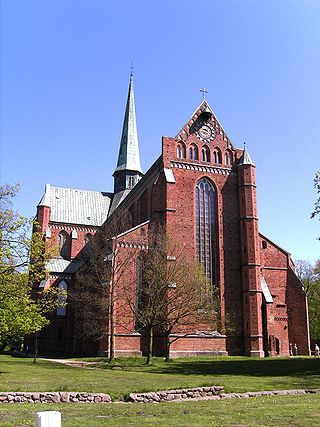
Neuburg Abbey near Heidelberg in Baden-Württemberg is a Benedictine monastery dedicated to Saint Bartholomew, and part of the Beuronese Congregation.

Zinna Abbey is a former Cistercian monastery, the site of which is now occupied by a village also called Kloster Zinna, today part of Jüterbog in Brandenburg, Germany, about 60 km (37 mi) south of Berlin. The village was established by Frederick II of Prussia as a village for weavers.

Baindt Abbey, otherwise the Imperial Abbey of Baindt, was a Cistercian nunnery in Baindt in the district of Ravensburg in Baden-Württemberg, Germany.

Malchow is a municipality in the Mecklenburgische Seenplatte district, in Mecklenburg-Western Pomerania, Germany.

Oberschönenfeld Abbey is a Cistercian nunnery in Gessertshausen in Bavaria, Germany.
Malchow is an Amt in the Mecklenburgische Seenplatte district, in Mecklenburg-Vorpommern, Germany. The seat of the Amt is in Malchow.

Vreta Abbey, in operation from the beginning of the 12th century to 1582, was the first nunnery in Sweden, initially Benedictine and later Cistercian, and one of the oldest in Scandinavia. It was located in the present-day municipality of Linköping in Östergötland.

Wienhausen Abbey or Convent near Celle in Lower Saxony, Germany, is a community of Evangelical Lutheran women, which until the Reformation was a Cistercian Catholic nunnery. The abbey owns significant artworks and artifacts, including a collection of tapestries and the earliest surviving example of a type of eyeglasses.

Amelungsborn Abbey, also Amelunxborn Abbey, is a Lutheran monastery in Lower Saxony, Germany. It is located near Negenborn and Stadtoldendorf, in the Landkreis of Holzminden in the Weserbergland. It was the second oldest Cistercian foundation in Lower Saxony, Germany, after Walkenried Abbey. It survived the Reformation by becoming Lutheran, and with Loccum Abbey, also previously Cistercian, is one of the only two Lutheran monasteries in Germany with an uninterrupted tradition. The abbey church, St. Mary's, is also the parish church of the abbey's former estate villages Negenborn and Holenberg.

Doberan Abbey is a former Cistercian monastery in Bad Doberan, Mecklenburg-Vorpommern, Germany. The Brick Gothic church continues in use as Doberan Minster.

Dargun Palace, previously Dargun Abbey, was a Cistercian monastery in Dargun, Mecklenburgische Seenplatte, in Mecklenburg-Vorpommern, Germany, in the former Grand Duchy of Mecklenburg-Schwerin, converted after its dissolution into a palace.

Veng Abbey was one of Denmark's earliest Benedictine monasteries. It was located in the village of Veng near Skanderborg, Region of Southern Denmark. Veng Church, the former abbey church, is still in use as a parish church and is the oldest remaining in the country.

Dobbertin Abbey is a former monastery, which from approximately 1220 to approximately 1235 accommodated a community of Benedictine monks, from approximately 1235 a community of Benedictine nuns, and from 1572 a women's collegiate foundation, located in the municipality of Dobbertin near Goldberg in the district of Ludwigslust-Parchim in Mecklenburg-Vorpommern, Germany. It stands on a spit of land in the Dobbertiner See and includes the only church with two towers in Mecklenburg.

Isenhagen Abbey is a convent in Hankensbüttel in the district of Gifhorn in the German state of Lower Saxony. It was a nunnery founded by the Cistercian order but is now a Lutheran women's convent. It is managed by the monastic chamber in Hanover.

Mariental Abbey, in the present-day municipality of Mariental in Lower Saxony, Germany, is a former Cistercian monastery founded in 1138, now used and owned by a Lutheran congregation of the Evangelical Lutheran Church in Brunswick.

The Abbey of the Holy Cross in Rostock, Germany, was founded in the 13th century by Cistercian nuns. It is the only fully preserved abbey in the city. The complex includes the former abbey church which is used today as the University Church (Universitätskirche). The remaining former convent buildings house the Museum of Cultural History for the city of Rostock.

Altzella Abbey, also Altzelle Abbey, is a former Cistercian monastery near Nossen in Saxony, Germany. The former abbey contains the tombs of the Wettin margraves of Meissen from 1190 to 1381.

St. Urban's Abbey is a former Cistercian monastery in the municipality of Pfaffnau in the canton of Lucerne in Switzerland. It is a Swiss heritage site of national significance.

Günterstal Abbey, earlier also Güntersthal Abbey, was a Cistercian nunnery that existed from 1221 to 1806 located in Günterstal, which today is a district in Freiburg im Breisgau, Germany.


















